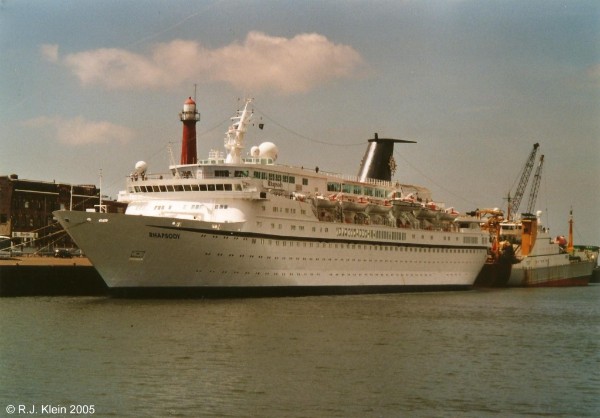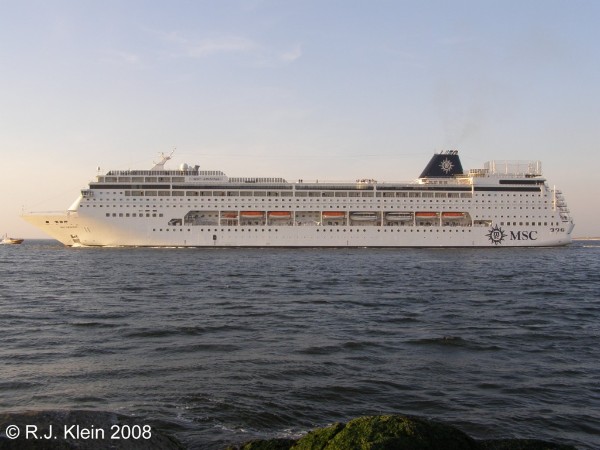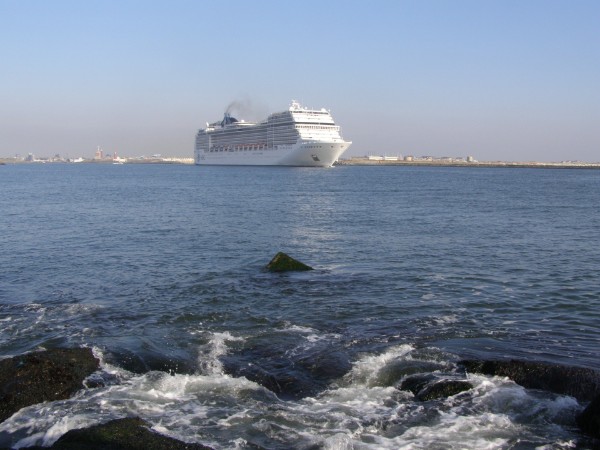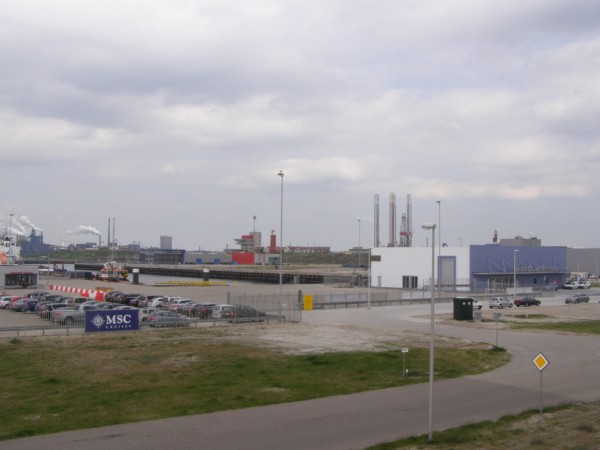MSC Cruises
MSC Cruises is the continuation of a much older company. This company was founded in 1964 as Lauro Lines by an Italian named Achille Lauro in Napels. He bought two former Dutch oceanliners, Willem Ruys from Koninklijke Rotterdamsche Lloyd and Oranje from the Nederland Lijn. He named Willem Ruys after himself, Achille Lauro, and Oranje got the name of his wife, Angelina Lauro. The ships were modernized and rebuilt totally, although they did not loose their handsome oceanliner looks. There was one major incident, when Angelina Lauro was rebuilt a big fire broke out and six people were killed.
The ships ran an immigrant serice between Europe and Australia, not unfamiliar for these ships who sailed this route also mostly in their Dutch years, being built for the route between Holland and the Dutch Indies (now Indonesia). Their most normal route was from Bremerhaven and Southampton to Sydney and Wellington via Suez. When the Suezcanal was closed, the ships sailed via Capetown. In 1970, the mail contract was lost by Lauro to the Chandris Line, the later Celebrity Cruises. The profits declined sharply and Lauro had the ships placed in full-time cruise service. This went without too much problems throughout the 1970's, but in 1979 the Angelina Lauro caught fire at St.-Thomas and to get the flames out so much water was poured into the ship that she sank at her berth. She was sold for scrap, although she never reached her final destination because she sank in the mid-Pacific on route to Taiwan.
Just sailing with one ship now, the 1980's began for Lauro Lines. But the problems were far from over. In 1985, terrorists from the Palestine Liberation Front hijacked the Achille Lauro when she sailed on a cruise between Alexandria and Port Said. One American passenger was murdered and because of this the diplomatic relations between the USA, Egypt and Tunesia became very edgy. Finally, also the Italian government resigned because of the incident.
All this was not good for the passengernumbers of the Achille Lauro, of course. In 1987 the company was bought by the Mediterranean Shipping Company and renamed StarLauro Cruises. MSC added a second ship to the fleet in 1990, when Monterey was bought from Aloha Pacific Cruises. This was an old ship, built in 1952 as Free State Mariner for the US Maritime Commission. In 1994, another disaster happened to the company when Achille Lauro caught fire while on a cruise between Genoa and Capetown. A rescue-operation was carried out, but for two passengers this came too late. The ship sank a few days later.
As a replacement, MSC added the also aging Enrico Costa from Costa Cruises and renamed her Symphony. It was the first time a ship for MSC was named in the music-theme. This was to become the most used theme in MSC shipnames. The ship was built in 1950 as the French liner Provence of the SGTM. In 1995, the cruiseships started sailing under the name of their mothercompany Mediterranean Shipping Company. This later changed again to MSC Cruises. Also in 1995, Rhapsody was bought from Cunard, where she sailed as their Cunard Princess. This ship was built in 1974 so somewhat more modern then her fleetmates. She is shown on the picture below, docked in the Vissershaven at IJmuiden in 2005.

The name MSC did not have anything to do with all problems of Lauro before so the company became a totally new one in general. With the backing of the great Mediterranean Shipping Company, that is one of the biggest shippinglines in the world, especially for containerized goods, the cruisecompany grew rapidly. So when the company was looking for larger and modern ships to add for replacing the older ships at the beginning of the new millennium, the bankrupcy of Festival Cruises came at the right moment for MSC. Festival Cruises was declared bankrupt in january of 2004 and MSC was eager to take over the newest ships of that company. They aquired the European Dream and the European Vision and renamed them MSC Sinfonia and MSC Armonia. Another pair of near sisters was built by MSC in the same period and they were MSC Lirica and MSC Opera. So in just two years four new and very modern ships were added to the fleet. But this was just the beginning of a huge building program like the industry doesn't see very often.
Below are three ships of the first new generation megaships of MSC, at first MSC Armonia at IJmuiden in 2008, followed by MSC Lirica in Amsterdam in 2009. Last of this trio is MSC Opera, also in Amsterdam, in june 2010.



After these aquisitions MSC started a big expansion of the fleet, not only in ships but also in size. The Musica class was built, a class of 90.000-tonners named MSC Musica (2006), MSC Orchestra (2007), MSC Poesia (2008) and MSC Magnifica (2010). Also, another class was built, the Fantasia-class of over 133.000 tons. These are the biggest cruiseships of any European cruiseline ever built. It consists out of the MSC Fantasia (2008), MSC Splendida of 2009, MSC Divina (2012) and MSC Preziosa (2013). MSC is now sailing with one of the youngest fleets in the world, after the older ships were transferred or sold to other companies.
Below, one of the Musica-class ships, the MSC Magnifica, is shown leaving IJmuiden at the 21st of april 2013.

Holland became a very important hub for the Northern European cruises of MSC, that were offered when more ships could be used. Amsterdam is one of the most important cruiseports in this part of the continent, but they have a slight problem because the city is situated around 25 kilometers inland. This is due to the fact that when Amsterdam had its golden age in the 17th century, the city was situated on an inlet of the inland sea Zuiderzee. With all Dutch water engineering works to stop the country from flooding, the inland sea was dammed off and Amsterdam was instead given access to the Northsea directly via the Northsea Canal. This was a very good connection, but in modern times, time is money and it costs ships around three extra hours to pass the locks at IJmuiden and then sail on to Amsterdam. Of course, they also have to get back to sea so another three hours are 'wasted'. MSC really wanted to use Amsterdam as a main hub, but this extra lost time was a big problem for them. In recent years, the port of IJmuiden, that is part of the Amsterdam Harbour Company too, is filling in the gap and a terminal was constructed in the first years of the new millennium. But the space here is rather small, so when a new dock was built on the former beach, it was decided to dock larger cruiseships here. Only problem was, there was no terminal. Talks between the Port Of Amsterdam and MSC resulted in MSC promising a large amount of sailings from The Netherlands, when a new terminal was built in the new dock of IJmuiden. Within six months during the winter of 2011/2012, the terminal was built to the specifications MSC gave. Nothing more, nothing less. During 2012, MSC ships docked around 35 times at the new terminal, sailing cruises within Northern Europe and down to Spain from here. The terminal is also used for other companies, Saga Holidays, Holland America Line and Pullmantur Cruises for example. Because of the recent growth of sailings from the terminal, the community of Velsen decided to enlarge the terminal by 100% and double the passenger capacity.

The new dock and terminal at IJmuiden, used by the MSC ships.
MSC is truly a very large operator nowadays, achieved in just over a decade. They are now the thirth largest cruiseline in the world, after Carnival and Royal Caribbean of course. Even the ships are getting larger themselves, because in the end of 2013 it was announced that the four ships of the Lirica-class will be lenghtened and updated throughout 2014 and 2015. Next to this lenghtening project, in march of 2014 the announcement also came that MSC ordered at least two 167.000-ton cruiseliners from the STX France wharf at St.-Nazaire. Also an option for two more ships of this class was signed. This class of ships will be the thirth largest class ever ordered, after Royal Caribbean's Oasis-class and Quantum-class.

